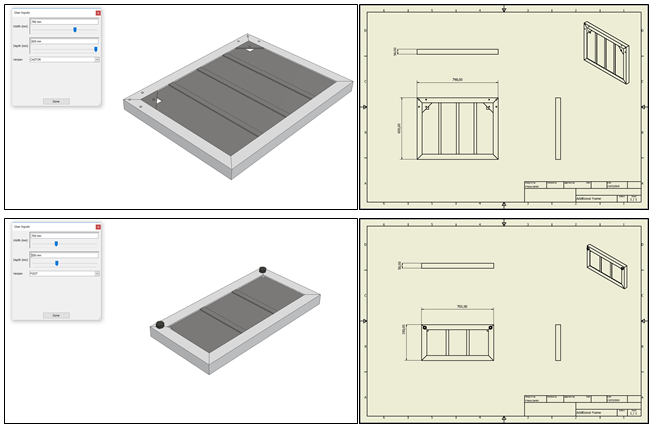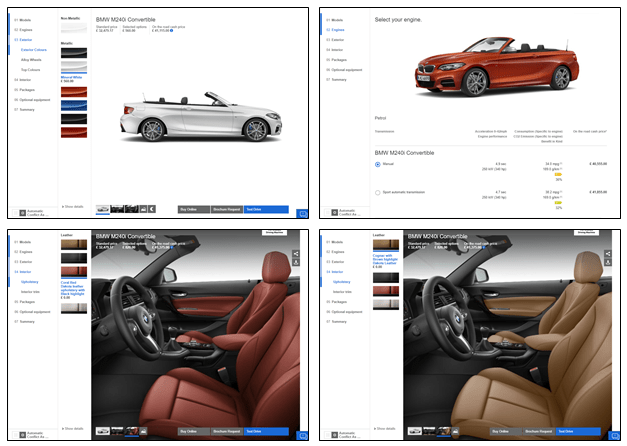In a simpler world, a design would come in one configuration – one geometry, one set of components, one paintjob – but alas, that is not the world we live in. A single design could encapsulate a plethora of configurations, and dealing with these efficiently, either at the design or marketing level, can make the difference between success and failure. So… what is a configurator?
Configurators
A configurator is simply a tool that allows a user to configure a design in an easy and user-friendly way. It may be nested within a 3D modelling program (like Autodesk Inventor), inside a rendering program (like VRED), or even hosted directly on a webpage. Its function is to allow a design to be configured according to inputs from the user.
The outputs depend on the type of configurator being used:
– For design work: Engineers may use a configurator for their design to produce accurate 3D models, drawings, bills of materials, cutting lists, etc.
– For marketing and sales: Marketers and Salesmen may place a configurator on their company’s webpage to allow users to visualise their customised product, and produce quote estimates automatically.
This article will explore these two types of configurators in greater detail.
Configurators for Design Work, or Way of the Old Masters
When the old masters of sculpture were to create a new statue, they would seldom start from scratch. The usual practice was to get an apprentice to make up the first 90%, and then they would come in to perform the master-strokes. The work of the apprentice, in this case, is the work of a ‘design configurator’.
In a modern setting, an engineering team may have a design “X” which is largely an archetypal model; that is, their other designs are mostly similar to it bar a few modifications. The most direct approach for this engineering team may be to create, from scratch, a new 3D model and set of drawings for each new design, but this is labourious. A more efficient approach may be to make copies of design “X” and modify them to create the new designs, but this too can be inefficient. The most artful way of dealing with this problem would be to create a configurator from design “X”. This entails:
– Designing the model parametrically (and perhaps even with some logic; see https://www.manandmachine.co.uk/parametrics-in-inventor/),
– Creating easy-to-use controls for the manipulation of parameters.
If executed properly, users would be able to create new designs using the archetypal “X” configurator. Once completed, they could save a permanent copy of the modified design, and this would become the new design. 3D models and drawings would be automatically updated, saving a lot of work and minimising the chance of error.
Let’s look at a real-world example. Here we have a frame that may be configured in width, length and footing-type. It also has lateral reinforcement bars which change in number in proportion to the width. Rather than remodelling and redrawing the frame every time we have a new configuration, here we have created a parametric model bolstered with logic (as this is Inventor, it is ‘iLogic’). We also have a dialogue that allows the user to quickly and easily modify the input parameters.

From the illustrations above, we see that not only is it easy to reconfigure the model, but that the corresponding drawings also update to reflect the changes. In this manner, a design configurator can save a lot of work and risk of error in the engineering office.
Customer-Driven Configurators for Marketing and Sales
Customers want to be able to customise their products. Customers also want to be able to see what they’re buying. This is fine if your product is highly standardised, like laundry baskets, but exponentially more troublesome if, say, you’re selling a car.
A car is a great example of a product that can be configured in a multitude of different ways. Today, it is very common for a new car to offer options for different transmissions, seats, wheels, interior panelling, accessories and paintjobs – just to name a few. From a marketing/sales perspective, this ability to customise is an important selling-point, and therefore, it behoves us to allow potential customers to visualise their custom configurations. A tool that does this would be regarded as a ‘marketing configurator’ and would usually exist on a website.
Like a ‘design configurator’, marketing configurators accept inputs from a user to reconfigure a design. However, for marketing, the goal isn’t to produce necessarily faithful and complete 3D models and drawings, but rather to produce rendered visualisations (and possibly cost estimates) which can be viewed by the customer. A beautiful example of this is BMW’s car configurator:
https://www.bmw.co.uk/configurator#/

On this website, potential clients can customise their BMW entirely, and have real-time access to visualisations both exterior and interior. To boot, they are also provided with an accurate cost estimate based on their options. Such configurators are often made with 3D modelling software (like Inventor) supplemented by rendering software (like Autodesk VRED), and can be rendered live or beforehand.
This is just one example of how a configurator can be a boon to sales and marketing.
Philosophy, Training and Consultancy
In addition to their massive boon to efficiency, I like configurators because their creation require us to boil down our designs to their essence. If you change the seats in your BMW M5, it still remains an M5. But what if you change the engine? The chassis and exterior panelling? At some point, it would cease to be an M5. A configurator must be designed in such a way that this cannot happen: it forces us to confront what is elemental to our design. Plato called this elemental stuff the ‘form’ of a thing, and it is nice to see how engineering connects back to philosophy so neatly.
But philosophy aside, the creation of a configurator requires knowledge of parametrics and logic (in the case of Autodesk Inventor, ‘iLogic’), and potentially the use of additional programs like Configurator 360. If you would like to learn the art of creating a configurator, either for the design office or for your customer-facing webpage, Man and Machine offer comprehensive training and consultancy services. Contact our sales team today, and we’ll have you making your own configurators in no time at all.
